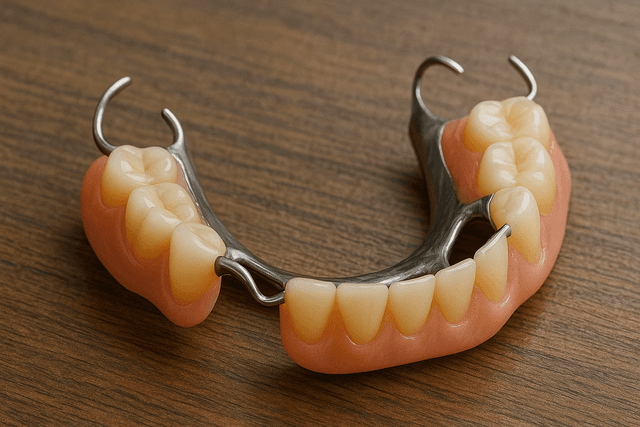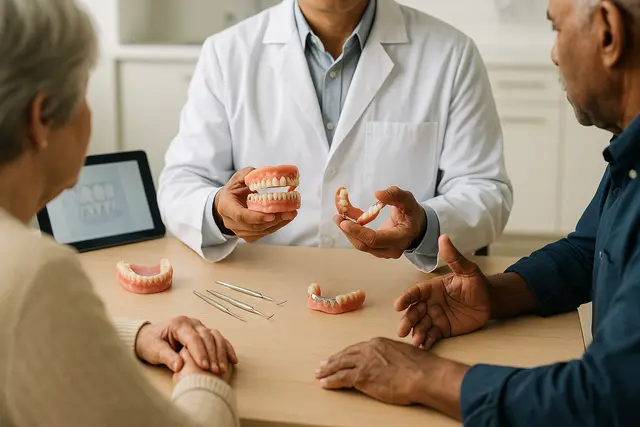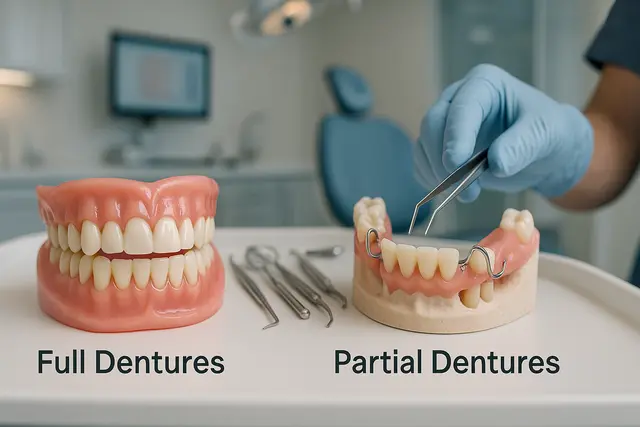Prosthodontics
5 min read
May 26, 2025
What Does a Partial Upper Denture Look Like? Types, Styles, and Fit Tips
Missing a few teeth in your upper jaw doesn’t mean your smile has to suffer. A partial upper denture is a smart, natural-looking way to fill those gaps without committing to a full set. Whether you’ve lost one tooth or several, this guide will walk you through what partial dentures look like, the different styles available, and how to make sure yours fits like a charm.

If you’ve ever tried to enjoy your favorite sandwich only to be reminded that a few key players on your dental team have gone missing teeth, you’re not alone. Tooth loss happens, and luckily, modern dentistry has a way to replace missing teeth without making your smile look like a costume prop.
One of the most trusted fixes? The partial upper denture. It’s subtle, snug, and when done right, it blends so well with your existing teeth that no one will know the difference but you. Let’s walk through what a partial upper denture really looks like, the types available, and how to keep it fitting comfortably and naturally.
Partial Denture: The Basics You Actually Want to Know
A partial denture is a removable dental prosthetic that fills in the gaps left by one or more missing teeth. It’s not a full set of dentures (which replace every tooth), but rather a custom solution used when some natural teeth remain. Whether it's just one or several teeth that are missing in the upper arch, a partial is designed to restore the function and aesthetics of your bite, without reinventing your entire mouth.
Upper partial dentures are made from a variety of materials, including acrylic, metal, or flexible nylon, and they’re often fitted with artificial teeth that are carefully customized to match the patient’s natural teeth in color, shape, and size. The goal? A natural-looking smile that doesn’t shout “dental work.”
What Do Upper Partial Dentures Look Like?
Think of a partial upper denture as a small, discreet tray that sits on the upper jaw and holds one or more artificial teeth in place. It typically rests against the gum and clips onto your remaining natural teeth using tiny clasps or precision attachments. Some designs may even include dental crowns on the adjacent teeth for extra hold.
Unlike full dentures that cover the entire upper palate, partials are shaped to fit around your remaining teeth. They’re carefully crafted to blend seamlessly with the natural teeth and gums, so everything looks like it belongs, because it does. For individuals with missing teeth in the upper arch, these dental prosthetics are one of the most effective and affordable ways to restore a natural-looking smile.
Types of Partial Dentures: What to Expect
There’s no one-size-fits-all when it comes to partial dentures, and that’s a good thing. Different types are available depending on the materials used, the number of teeth needing to be replaced, and the patient’s oral health.
Here are the most common styles:
Acrylic Partial Dentures
These are often used as temporary solutions or for quick replacements. Made from acrylic resin, they’re budget-friendly and quick to produce. However, they can be bulkier than other types and may require more frequent adjustments due to wear.
Flexible Partial Dentures
Flexible partials are made from nylon-based materials that offer more comfort and a tighter fit. They’re especially good for patients who have difficulty with metal clasps or have sensitive gums. Plus, they’re lightweight and can blend beautifully with natural gums.
Cast Metal Framework Partials
Considered the gold standard for many dental professionals, this type of upper partial denture features a thin metal base (usually cobalt-chromium) that supports the artificial teeth and clasps. These dentures often last eight years or more before needing replacement due to wear, and they provide excellent durability and a precise fit.
Removable Upper Partial Dentures vs. Fixed Options
Most partial dentures are removable, meaning you can take them out at night for cleaning or give your gums a break during the day. But there are also fixed partial dentures, also called dental bridges, which are cemented into place using crowns on the adjacent teeth. Your dental professional will help you decide which option fits your lifestyle and dental health best.
Fit Tips: Making Sure It Feels Like It Belongs
Wearing your partial denture shouldn’t feel like juggling marbles with your tongue. A well-fitting denture should sit securely against the gum and existing teeth, without sliding, clicking, or causing pain.
Here’s how to keep the fit (and comfort) just right:
See your dentist regularly: Gums and remaining teeth can shift over time, which means your partial may need occasional adjustments.
Practice speaking and eating: It might feel odd at first, but your mouth will adapt. Start with softer foods and work your way up to crunchier options.
Keep it clean: Remove and rinse after meals, and clean your denture with a soft brush and non-abrasive cleaner. Your oral health will thank you.
Watch for sore spots: If something rubs or pinches, don’t tough it out. That’s a sign it needs a tweak.
Lower vs. Upper Partial Dentures: What’s the Difference?
While this article is focused on what upper partial dentures look like, it's worth noting how lower partial dentures compare. Lower partial dentures are designed to fit around the remaining teeth in the lower jaw. Just like their upper counterparts, they’re custom-made and can be acrylic, flexible, or metal-based.
But because the tongue lives in the lower arch, they need to fit a bit differently to avoid crowding your mouth. Lower partial dentures can also come with their own set of challenges, so they’re always custom-tailored by your dental professional.
Final Thoughts
Partial dentures restore more than just missing teeth, they restore confidence. They’re a way to replace missing teeth at a fraction of the cost of dental implants or bridges, and when they’re done right, partial dentures look like natural teeth. Whether you’re getting a final partial for long-term wear or trying out removable partial dentures for the first time, a good fit, a smart design, and a bit of patience will make all the difference.
And hey, if you’re wondering how partial dentures are made or which type of upper partial denture is best for your lifestyle, don’t be shy, your dental professional’s got your back (and your bite).
What Is an Upper Partial Denture and Who Needs One?
An upper partial denture is a removable dental appliance that fills in gaps from one or more missing teeth in the upper jaw. It's ideal for patients who still have some natural teeth and want to restore both appearance and function without committing to a full denture or implants.
What Types of Upper Partial Dentures Are Available?
Common types include acrylic partials (affordable and often temporary), flexible partials (comfortable and gum-colored for a natural look), and cast metal framework partials (durable and long-lasting). Each type offers different benefits based on comfort, fit, and budget.
Will My Upper Partial Denture Look Natural?
Yes, when properly designed, upper partial dentures blend seamlessly with your natural teeth. The artificial teeth are color-matched, and the gum base is shaped to fit your mouth. Flexible or cast metal options often provide the most realistic appearance and secure fit.
How Do I Keep My Upper Partial Denture Comfortable and Secure?
A good fit starts with a custom design, but maintenance is key. Clean your denture daily, avoid overly sticky foods, and see your dentist regularly for adjustments. If it ever slips, causes sore spots, or feels off, it likely needs a simple tweak for better comfort.
Read Next
Related Posts

Prosthodontics
Differences Between Zirconia and Acrylic Dentures: Benefits, Drawbacks, and Tips
Choosing between zirconia and acrylic for dental implants can feel overwhelming, especially when both materials offer unique advantages. This guide breaks down the essential differences, benefits, and limitations of each option to help you make a more confident, informed decision about your dental restoration journey.
5 min read
Nov 03, 2025

Prosthodontics
Dentures vs. Partial Dentures Pros and Cons: Helping You Make the Best Choice
Tooth loss can impact everything from your self-confidence to your ability to enjoy your favorite foods. Fortunately, modern dentistry offers practical solutions that restore both function and aesthetics. Two of the most common options are full dentures and partial dentures, each with its own advantages and limitations.
5 min read
Nov 03, 2025

Prosthodontics
Partial Dentures vs. Full Dentures Comparison: What Works Best for Your Situation
Choosing between partial and full dentures is an important step in restoring both your smile and confidence. With each option designed to meet different dental needs, understanding their differences can help you make the right decision for your oral health and lifestyle.
5 min read
Nov 03, 2025
Don’t have time to research every dentist around you?
See why 30k+ patients trusted us